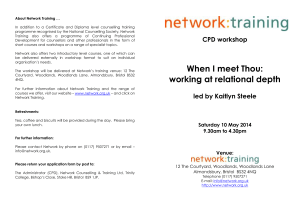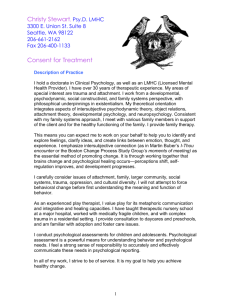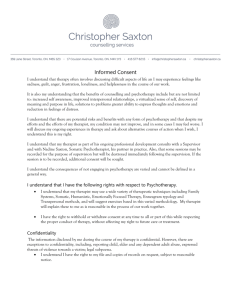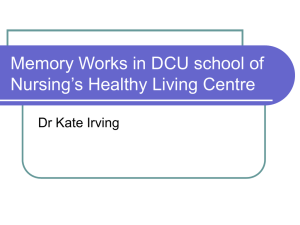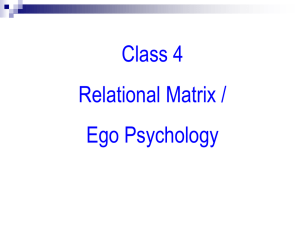- White Rose Research Online
advertisement
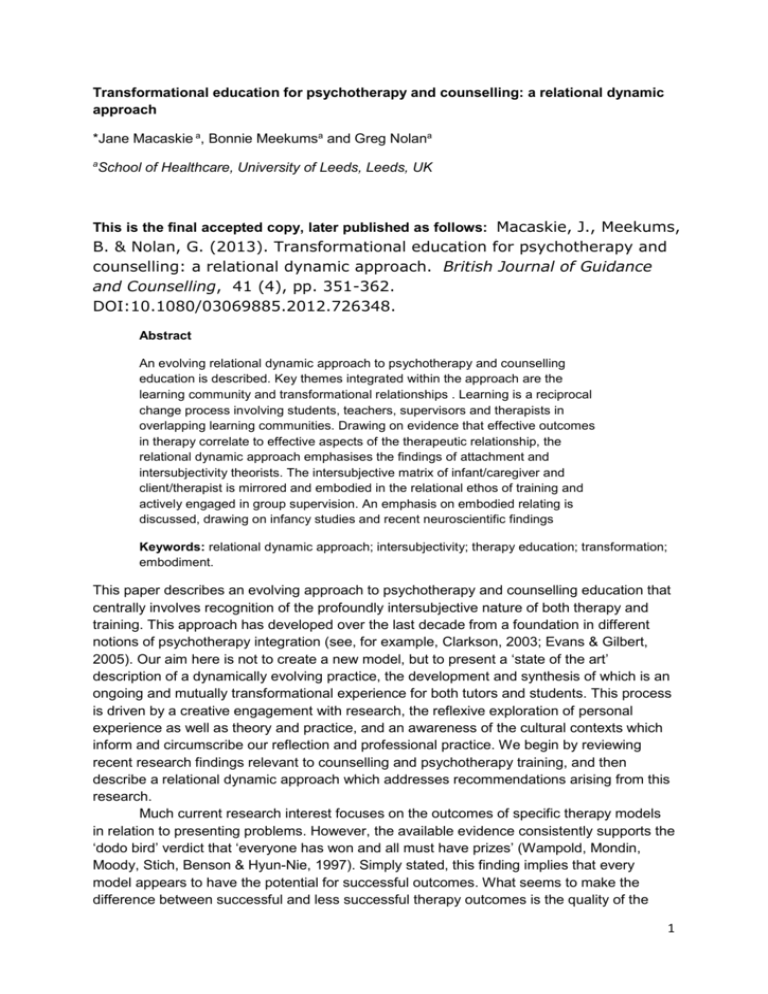
Transformational education for psychotherapy and counselling: a relational dynamic approach *Jane Macaskie a, Bonnie Meekumsa and Greg Nolana a School of Healthcare, University of Leeds, Leeds, UK This is the final accepted copy, later published as follows: Macaskie, J., Meekums, B. & Nolan, G. (2013). Transformational education for psychotherapy and counselling: a relational dynamic approach. British Journal of Guidance and Counselling, 41 (4), pp. 351-362. DOI:10.1080/03069885.2012.726348. Abstract An evolving relational dynamic approach to psychotherapy and counselling education is described. Key themes integrated within the approach are the learning community and transformational relationships . Learning is a reciprocal change process involving students, teachers, supervisors and therapists in overlapping learning communities. Drawing on evidence that effective outcomes in therapy correlate to effective aspects of the therapeutic relationship, the relational dynamic approach emphasises the findings of attachment and intersubjectivity theorists. The intersubjective matrix of infant/caregiver and client/therapist is mirrored and embodied in the relational ethos of training and actively engaged in group supervision. An emphasis on embodied relating is discussed, drawing on infancy studies and recent neuroscientific findings Keywords: relational dynamic approach; intersubjectivity; therapy education; transformation; embodiment. This paper describes an evolving approach to psychotherapy and counselling education that centrally involves recognition of the profoundly intersubjective nature of both therapy and training. This approach has developed over the last decade from a foundation in different notions of psychotherapy integration (see, for example, Clarkson, 2003; Evans & Gilbert, 2005). Our aim here is not to create a new model, but to present a ‘state of the art’ description of a dynamically evolving practice, the development and synthesis of which is an ongoing and mutually transformational experience for both tutors and students. This process is driven by a creative engagement with research, the reflexive exploration of personal experience as well as theory and practice, and an awareness of the cultural contexts which inform and circumscribe our reflection and professional practice. We begin by reviewing recent research findings relevant to counselling and psychotherapy training, and then describe a relational dynamic approach which addresses recommendations arising from this research. Much current research interest focuses on the outcomes of specific therapy models in relation to presenting problems. However, the available evidence consistently supports the ‘dodo bird’ verdict that ‘everyone has won and all must have prizes’ (Wampold, Mondin, Moody, Stich, Benson & Hyun-Nie, 1997). Simply stated, this finding implies that every model appears to have the potential for successful outcomes. What seems to make the difference between successful and less successful therapy outcomes is the quality of the 1 therapeutic relationship. Norcross and Wampold’s (2011a) summary of ‘what works’ in evidence-based therapy relationships, as distinct from therapy modalities, indicates that particular features of the relationship (the therapeutic alliance, cohesion in group therapy, empathy and collecting client feedback) are demonstrably effective. Goal consensus, collaboration and positive regard are found to be probably effective, while congruence, repairing alliance ruptures and managing countertransference are ‘promising’ features for which the authors state that as yet there is insufficient evidence available. In a related paper, Norcross and Wampold (2011b) make several recommendations, including some which are specific to training and which the approach described here seeks to apply. Training programmes ‘are encouraged to provide competency-based training in the demonstrably and probably effective elements of the therapy relationship’ and ‘in adapting psychotherapy to the individual patient in ways that demonstrably and probably enhance treatment success’, while accreditation bodies ‘should develop criteria for assessing the adequacy of training in evidence-based therapy relationships’ (Norcross & Wampold, 2011b, p. 99). It is significant that in both these papers, Norcross and Wampold present research which, as they point out, evidences what therapists have always intuitively recognised – that responsive relating to individual clients is the key to successful therapy. What makes for responsive relating, according to Norcross and Wampold (2011a), demonstrably includes attention to the here-and-now dynamics of resistance, client preferences, culture and spirituality, and probably includes stages of change and coping style. Client expectations and attachment style were also thought to be related to outcome but insufficiently evidenced at this stage. The approach described in this paper seeks to develop the competencies outlined above and to encourage flexible adaptation to each client through attention to relational dynamics, cultural awareness, stages of change and attachment patterns, with an actively enquiring focus on client preferences and expectations. In short, the relational dynamic approach is based on deepening awareness of the intersubjective matrix between therapist and client in both its conscious and unconscious manifestations. We aim to describe the relational dynamic approach in a way which is usable for students and colleagues in the wider academic and professional communities, in the sense and spirit of Winnicott’s (1971) concept of the use of an object. Winnicott’s account of the development of object use as distinct from object-relating is a significant starting point for intersubjective theory (Benjamin, 1990). It emphasises the otherness of those whom the infant learns to engage with as separate beings, thereby establishing a relation with external reality rather than just fantasy. Although we prefer to think of persons as ‘subjects’ rather than ‘objects’, Winnicott’s language reflects the way in which ideas as well as people offer us a ‘third’ perspective (Britton, 1998) to use as a reality check on our cherished fantasies. We hope the relational dynamic approach to therapy education described here will similarly offer ideas to be used, engaged with, critiqued and even ‘destroyed’ in Winnicott’s (1971) sense, as part of the dialectical process of thinking and generating knowledge within the profession. The present state of our art is always provisional, and we welcome dialogue which may lead towards the transcendence of its current limitations. While a failure to move beyond object-relating means that interpersonal relationships remain based on fantasy and projection rather than engagement with external reality, postmodern theories challenge the concept of a static knowable reality ‘out there’. Theoretical concepts are understood to emerge from the historical and cultural context in which they are embedded and to retain within them a matrix of ‘givens’ from their time and place, which may not be readily applicable or comprehensible in other contexts. Although the notion of theoretical truth is easily reified as a discovery of the founding fathers and mothers 2 of psychotherapeutic theories, a postmodern perspective suggests a plurality of truths seen from a variety of perspectives, continually co-constructed through embodied ‘participatory sense-making’ (De Jaegher & Di Paulo, 2007). We believe this perspective is closer to the therapeutic experience of emerging from rigid patterns of defensive thinking into new ways of perceiving and perhaps more creative ways of living. This more fluid understanding is at the heart of the intersubjective perspective which informs our approach to therapy education. As stated above, Winnicott’s concept of object use lays one of the foundation stones of intersubjectivity theory (Benjamin, 1990). While object relations theory focuses on ways in which each person weaves the fabric of their own internal world, in turn drawing in threads from experience and creating a veil through which to view the external world, theories of intersubjectivity pay attention to the irreducible nature of others and the relational quality of all our experience. Other people are not simply the objects of our desires, fears, identifications and projections, but embodied subjects in themselves and in relation with us. The move beyond object-relating which Winnicott (1971) outlines is a key step towards developing the capacity for intersubjective experience and understanding. From this perspective what we know and believe about each other and the world is co-created between people in particular relational contexts. A binary opposition of internal and external worlds is troubled by this understanding, so that experience is understood to be neither wholly objective nor reduced to inner fantasy. This perspective assumes the capacity to recognise the other as other (Benjamin, 1990), and so implies a deeply-rooted mutual recognition and acceptance of difference lying at the heart of ethical therapeutic relationships. Ethical practice occupies a central position in the relational dynamic approach. Practitioners have a responsibility for ethical thinking which requires a lived rather than learned experience of the attitudes and values from which ethical thinking derives (Casemore, 2009). Understanding the other, however empathically, is not on its own enough to bridge the imaginative gap which separates us, because it does not necessarily involve recognition of our own presence and engagement in the encounter. However, once the possibility of knowing the other objectively is radically challenged, as it is by postmodern theories, ethical relationships demand that we take account of the culturally normative intersubjective processes such as exclusion and minoritisation by which some others are denied visibility and audibility (Chantler, 2005). Critical reflexive questioning is needed to help us develop awareness of how we as practitioners are caught up in these processes and may contribute to their perpetuation in relation to our clients and students. Intersubjectivity theory is understood in the relational dynamic approach to underpin the ethical practice of counselling and psychotherapy. It also forms the basis of our educational approach. Drawing on an understanding of the significance of the wounded healer archetype for the helping professions (Guggenbühl-Craig, 1971), we recognise the potential for narcissism inherent in the roles of teacher, therapist, healer and, of course, writer. The dynamics of ‘helping’ relationships including teaching are prone to projections whereby the power of having knowledge and skill can all too easily be located in the ‘helper’ and denied to the other. Wounded healers (teachers, writers), however, recognise their fallibility and limitations through a reflexive process of self-questioning and are open to receiving from the other, the one who in theory needs ‘help’ of some kind. The archetype is then no longer split between one who knows and one who does not, and both may share its strengths and weaknesses. If teachers can learn, students are better enabled to find their own wisdom and source of authority. In teaching students to become therapists, our intention is also to learn from them through the insights and experiences they bring to the 3 training group, and thus to help the group to a deeper awareness of the intersubjective processes of knowledge creation. The position taken in this paper is provisional, and in writing the paper the relational process between the authors has involved much reflection and deconstruction. This mirrors the evolving nature of our collaboration as a teaching and scholarly team, in which our intersubjective processes generate refinements of theoretical perspective and pedagogical practice. This is what makes it fun! We now discuss two key themes integrated within the relational dynamic approach: the learning community and transformational relationships. The learning community counselling and psychotherapy profession counselling & psychotherapy research local practitioner networks: placements, supervisors, therapists students and tutors within the university community Practitioner education is embedded in multiple communities of practice, including the student-staff group, local networks of placement providers, supervisors and therapists, the expanding field of therapy research and the profession as a whole, as well as the university and wider academic community (Figure 1). Relationships between and within these communities strongly influence the currency of theoretical concepts, notions of acceptable practice, and the ways in which students are inducted into the profession. The concept of legitimate peripheral participation (Lave and Wenger, 1991) suggests that ‘social practice entails learning as an integral constituent’ (p. 35). This implies that that the skills, theories, values and attitudes of practices such as counselling and psychotherapy are not static but continually being learned and transformed by learners, who potentially include experienced as well as new practitioners. Occupying a ‘peripheral’ position makes it possible to adopt a critically reflexive stance towards professional ideas and towards the profession’s historic tendency to polarise by identifying with some ideas and rejecting others on the basis of cherished ideology. Lave and Wenger’s (1991) concept does not imply that ‘legitimate’ and ‘peripheral’ are mutually exclusive terms, since ‘complete participation would suggest a closed domain’ characterised by stages of ‘acquisition by newcomers’ (p.36). A 4 closed domain is one where the ‘truth’ is held by those at the top of the hierarchy and newcomers must identify with this orthodoxy to gain acceptance. Discussing this type of learning community as a ‘good child’ model of psychotherapeutic training, Rizq (2009) suggests that it encourages the trainee’s development of a false self (Winnicott, 1960/1987), dependent on and identified with the tutor. In contrast, we are seeking to promote learning as mutual participation in the discovery and sharing of knowledge between students and more experienced practitioners such as tutors, supervisors, mentors and researchers. Newcomers are thus seen as legitimate members of their communities of practice whose presence can be transformative, and ‘old timers’ (Lave & Wenger, 1991, p.29) are open to challenge and change. Arguably, this model also describes the learning which takes place in the therapeutic context. This view of learning practices fits well with an approach that invites a critical reading of a range of theories and positions. Rizq (2006) has argued that pluralistic trainings require of the learner an ability to take up a ‘third position’ (p. 616) in relation to psychotherapeutic theories. Being denied the comfort of an identificatory relation to a single model, learners need to develop an internal reflective space where they can try out different perspectives on practice, and consider theories as partial and contextually-situated frameworks for thinking. This is challenging, but the endeavour to transcend the limitations of current thinking including our own is an essential aspect of learning in dynamic communities of practice. Consequently, relationships between these overlapping communities of practice are an important part of practitioner education. We believe that as educators in a university setting our role includes drawing on the knowledge and experience of practitioners living with the changing contexts of therapy provision in the British National Health Service and voluntary sector, through building relationships with placement providers and supervisors and inviting contributions from them as part of the teaching programme. It is equally important to encourage a flow of ideas from the academic community to the different contexts of practice, and writing this paper represents one way in which we seek to do this. Another way is by communicating a critically informed attitude towards therapy research, so that this does not remain separate from the ‘real’ world of practice nor from the skills and knowledge that therapists have already acquired (Macaskie & Lees, 2011). Transformational relationships Central to the relational dynamic approach is the recognition that transformation of self and other arises in relationships, potentially throughout life. In this section we outline some of the theoretical and research-based accounts of infant-caregiver intersubjectivity underpinning the relational dynamic approach, and consider ways in which the practices of therapy, supervision, education and collegiality also offer a potential matrix of transformation. Winnicott (1964, p.88) famously remarked that ‘there is no such thing as a baby’, but always a baby in relation to someone - a (m)other. The predominance of the metaphor of the mother-infant dyad for the therapeutic couple can be criticised on the grounds that it perpetuates the power of the therapist role and neglects the mature personality of the client, as well as other significant relationships such as siblings (Coles, 2003). Nonetheless, the recent upsurge of research into mother-infant intersubjectivity, and the correlation it suggests with other attuned and embodied processes in human interaction, makes this a key theoretical area for counselling and psychotherapy. Lyons-Ruth (1999, p.603) argues for a ‘”common structure” view’ in which parent-child and therapist-client relationships both offer ways of describing co-constructed processes of change. She conceptualises these ‘not in terms of the adult’s regression to or fixation at a stage of infancy or childhood, but in terms of 5 the similarities through which humans of all ages approach and progress through the mastering of the complex task domain of negotiating with other minds’ (Lyons-Ruth, 1999, pp. 603-4). Thus the focus of relational dynamic practice is not only on the symbolising of dynamically unconscious material, usually in language, as it is in much psychoanalytic practice, but crucially includes the possibility of ‘new forms of organisation emerging as new forms of “being with” are scaffolded between parent and child’ (Lyons-Ruth, 1999, p. 608) and correspondingly between therapist and client. Consequently, one of the key features of the relational dynamic approach is its emphasis on the awareness of embodied experiencing and relating. Students are encouraged to pay attention to their somatic state in the presence of and in response to clients, using this information as an intersubjective indicator of the changing dynamics and processes in the therapeutic relationship. They are also invited to notice their embodied responses in the context of concepts introduced in teaching sessions, and then to explore these either individually or in small groups. This reflective focus on experiencing in the present helps to ground theory by integrating left and right hemisphere processing of its meanings and resonances. Specifically, embodied experiencing is understood as relational. The notion of dance as an embodied metaphor for attuned relating expresses the intersubjectively regulated movement of client and therapist, student and student, student group and tutors, whose mutual impact operates at multiple levels in and out of awareness. Neuroscientific research on mirror neurones helps to explain some of the processes involved in nonverbal regulatory interactions. Mirror neurones are important in understanding emotion; the same neural networks operate whether we are witnessing an expression of emotion or actually experiencing it (Gallese, Eagle & Migone, 2007). Gallese et al (2007) suggest that we directly understand the other’s emotional state through embodied simulation, thus producing a shared body state. They call this process intentional attunement. This embodied attunement between therapist and client has been visually documented by McCluskey (2005), and provides a fruitful resource for trainees and more experienced practitioners to reflect on the embodied intersubjectivity of the therapeutic relationship. The implications for therapist training are that trainees need to develop their capacity to tune into their own bodies, emotional states and images, and the embodied communication of the client, which may be conveyed through movement, body language, metaphor, intonation and rhythm, and silence as well as words. One of the aims of the relational dynamic approach is to deepen experiential awareness of these relational processes through attention to the intersubjective dance of training relationships. Pre-natal experiencing, post-natal separation and pre-verbal language formation are central features of research by the Boston Change Process Study Group [BCPSG], from whose work derives the therapeutically helpful notion of ‘moments of meeting’ in emotionally linked infant and mother interaction (BCPSG, 2010; Stern, 2004). BCPSG (2010, p. 37) suggest that ‘moments of intersubjective meeting are experienced and represented in the implicit relational knowing of infant with caregiver’, and also in the therapist-client relationship, which thus has the potential to modify the client’s implicit relational knowing. This implicit level of knowing how to be in relation to another draws on Bowlby’s (1973) concept of internal working models, and in the BCPSG research is directly grounded in observed mother-infant interaction and relational psychoanalytic practice. Implicit relational knowing is not solely a set of cognitive schemata, but includes implicit body memory. In therapy, moments of meeting are moments with the potential for transformation through shared implicit and emotional experience. Arguably, Mearns and Cooper’s (2005) notion of ‘relational depth’ also points to interaction that includes this implicit level, although these 6 authors do not use this concept. Benjamin’s (1990) concept of mutual recognition specifically validates the attuned sense of each other as distinct yet in these moments profoundly connected. These perspectives on intersubjective relating are replicated to a degree in individual and group supervision. Nolan (2008) explores the processes of making sense of the relational dynamics manifested when significant ‘meaning-moments’ occur in the supervisory relationship. These are experienced in similar ways to the non-verbal implicit interactions outlined above. Perception is heightened when the therapist ‘dwells within’ (Nolan, 2008, p. 70) client processes which are sometimes understood as regressive, and sometimes as embodying spiritual wisdom. These then touch the therapist’s own sensing and empathic perceptions as well as counter-transferences, and are potentially witnessed with the supervisor in a parallel process that mirrors dynamic elements of the therapeutic relationship. Group supervision can facilitate similar experiences. Group members are encouraged to notice phenomena such as intuited or embodied awareness, which may be specifically facilitated when split-off aspects of the client, the therapist, or the relationships impacting on them are made conscious by different members of the group. It sometimes seems that the physical position of supervisees within the circle acts as an embodied metaphor for the position they take up in relation to the work being presented; however, this is an intuitive observation which awaits future empirical validation. The concept of the ‘populated intersubjective dyad’ (Nolan 2008, p.204) captures the historicity of the clienttherapist and supervisor-supervisee relationships, in which each member of the dyad carries the echoes and presences of past and current relationships. These may unconsciously influence experiencing in the present until made conscious through shared reflection. In group supervision, such phenomena are sometimes recognised more readily than in one-to-one supervision, since they become visible in the group dynamics. A similar impact on the dynamics of groups embedded within organisational settings is further explored by Nolan and Walsh (2012). The relationship of student and supervisor has been implicitly compared to a masterapprentice relationship in which the student therapist develops from novice to journeyman and eventually achieves mastery (Inskipp & Proctor, 1993). However, in the light of Lave & Wenger’s (1991) model of ‘legitimate peripheral participation’ and the overlapping communities of practice discussed above, the training approach outlined here requires a mutual exchange and influence between practitioners of differing expertise. Supervisors offer students a ‘secure base’ (Bowlby, 1988) for their practice and a challenge based on the wisdom of experience, and are also hopefully open to challenge from new thinking and research. Students are encouraged to develop a relational reflexivity in dialogue with their supervisors and therapists as well as peers and tutors, so that they do not simply imitate the model provided but apply critical awareness to these professional relationships. A critical reflexive stance can only grow if students feel safe enough, and safety depends on experiencing recognition and respect for themselves in intersubjective professional relationships (Rizq 2009). Meekums (2007) also highlights the importance of psychological safety in the supervisory relationship in order to let go into a state of ‘embodied not knowingness’ (p. 27) leading to the capacity for wisdom ‘beyond logic’ (p. 18) in the form of spontaneous embodied symbolism. Therapist training necessitates developing an extended self-awareness, which is encouraged in the relational dynamic approach through the personal development group and personal therapy as well as experiential pedagogic approaches and a critically reflexive 7 engagement with theory. The training experience continually requires students to reflect on the personal implications of their theoretical learning; they are given the opportunity, for example, to reflect on their own attachment styles, and theoretical concepts are critically considered in relation to students’ client work and personal experience as well as other theoretical approaches. This process throws up considerable challenges to settled perceptions of family and other relationships, and students may experience a temporary ‘madness’ as they engage with unexplored aspects of themselves. Personal therapy is therefore seen as an essential part of the training which facilitates working at depth in a challenging and containing relationship. It is noticeable in training situations and group supervision that insight into practice seems to be enhanced when students are able to explore their own experience in this way, an observation that corresponds to the findings of Rake and Paley (2009). Their research suggests that therapists learned more about themselves and more about practising therapy from their experiences as a client, though they also noted that the unsettling nature of this experience was in some cases perceived as negative. Rizq and Target (2008) similarly found that personal therapy was seen by practitioners as a source of greater reflectiveness in their clinical work. These authors’ later study (Rizq & Target, 2010) related therapists’ experiences of personal therapy to their attachment style and rating for reflective function (RF), and found that therapists with higher RF levels, who were more likely to have secure attachment patterns, tended to perceive positive impacts of their therapy on their client work, though this was not the case for those with lower RF levels and more insecure attachment. There is evidence, however, that engagement with therapy can both modify attachment styles and enhance reflective functioning (Beebe, Knoblauch, Rustin & Sorter, 2005). This finding accords well with some of the principal aims of therapy training, which are to develop reflexive self-awareness within relationships and reflective practice. While it can never be assumed that trainees will automatically gain as practitioners from their experience as clients, there is evidence that this is so in many cases and that reflective capacity is also likely to be increased through such experience. For these reasons, we regard personal therapy as a significant building block in training, along with personal development group work and practices such as reflective journalling (Wright & Bolton, 2012). The personal development group is a feature of many if not all therapy trainings, and its value lies precisely in the opportunity it offers to increase awareness of self in relation to others. It emphasises the intersubjective in a way no other setting can because the individual cannot regress in the same way as a client. One has to take responsibility for one’s impact on others (as in group psychotherapy). It also develops a key employability skill as it develops the capacity to contribute to the emotional literacy of work teams. The tutor-student relationship is centrally important in the trainee experience because tutors as educators, mentors and professional practitioners are able to model their practice and facilitate learning through ‘connoisseurship’ (Polanyi, 1969) of their professional skills and being. Additionally important is the sharing of experience and professional wisdom to illustrate theoretical ideas. But learning is not one-way; it is a joint enterprise, a mutual dialogue in which tutors gain insight from trainees through valuing their life experience and wisdom. It involves the inculcation of mutual respect and recognition, a humility that avoids the kind of knowing that forecloses but sustains curiosity towards the potential to learn from each other. However, tutor-student relationships are inevitably also a site of major transferences and projections of good/bad parent place the tutors under great pressure to conform to these roles. Staff countertransference, experienced through bodily phenomena as well as affect, thoughts, and imagery provides a helpful way of understanding the pull into 8 object-relating to which the teaching role is sometimes prone. The teaching team use dedicated supervision to reflect on how they are positioned both individually and collectively as transference objects and recipients of projective identification, and how dynamics within the team may sometimes reflect what is going on in tutor-student and student-student relationships. Object usage (Winnicott 1971) of the tutors, as real others to engage with, emerges when we can embody something more than fantasy and projection for our students. When ‘nice daddy’ holds a boundary or ‘bad daddy’ displays unlooked-for empathy and caring, there is a sudden recognition of the tutor as a real other person. The shock of recognition seems to clear the ground for a more complex growing awareness that therapist education is a work in progress for everyone involved. Two brief examples may illustrate the emergence of a transformed tutor-student relationship. One of us felt for some time that she wanted to communicate her changing perspectives on psychotherapeutic theories and practices to her students, but hesitated out of fear that this might undermine their learning. The presence of something unspoken became almost tangible to the tutor, who eventually took the risk of saying that as a practitioner-trainer and researcher, she occupied a position of radical doubt in relation to the theories and practices she had lived by for much of her professional life. At the same time she had faith in the capacity of relationships (not just therapeutic relationships) to be a crucible for transformation and growth. This admission felt like stepping into the unknown. The response of the student group ranged initially from puzzlement to curiosity and engagement in the effort to understand the tutor’s letting go of theoretical scaffolding and the authority it conferred. In the ensuing discussion the tutor felt a greater equality with the group in seeking for knowledge from inside our joint experiencing and students acknowledged the learning that emerged from this new challenge. A second example comes from a student at the end of the training programme. In our final group meeting she said, ‘It feels like we’ve been with you since we were little’. It was as if our relationship had grown from one in which she was ‘little’ and dependent, needing security and identifying with the tutors as transformational objects (Bollas, 1987; Rizq, 2009). This has been replaced by a transformed relationship in which she is a young adult leaving home, wanting and receiving recognition as a mature and independent practitioner. Crucially, she knows and we know that she is no longer ‘little’. Conclusion The relational dynamic approach discussed here is firmly based in the work of intersubjective theorists, and draws on Winnicottian concepts, attachment theory and a concern for the relational values implicit in humanistic psychology. It also draws on professional educational theory (Lave and Wenger, 1991) in order to integrate these into a learning community which is open to change. Change processes are at the heart of both the therapeutic endeavour and the transformational practitioner education we have outlined here. Significantly, they affect both tutors and students and offer to both the possibility of continuing growth. References Beebe, B., Knoblauch, S., Rustin, J & Sorter, D. (2005). Forms of Intersubjectivity in Infant Research and Adult Treatment. Hillsdale, N.J.: Analytic Press. Benjamin, J. (1990). An outline of intersubjectivity: the development of recognition. Psychoanalytic Psychology. 7(Suppl), pp.33-46. 9 Bollas, C. (1987). The Shadow of the Object: Psychoanalysis of the unthought known. London: Free Association Books. Bowlby, J. (1973). Attachment and Loss: Vol. 2. Separation: Anxiety and Anger. Harmondsworth: Penguin. Bowlby, J. (1988). A Secure Base: Clinical applications of attachment theory. London: Routledge. Britton, R. (1998). Belief and Imagination. London: Routledge. BCPSG. (2010). Change in Psychotherapy: A unifying paradigm. New York: W.W. Norton. Casemore, R. (2009). Ethics as a way of being. In L. Gabriel and R. Casemore (Eds.). Relational Ethics: Narratives from counselling and psychotherapy (pp. 23-31). London: Routledge. Chantler, K. (2005). From disconnection to connection: ‘race’, gender and the politics of therapy. British Journal of Guidance and Counselling, 33, pp. 239-56. Clarkson, P. (2003). The Therapeutic Relationship (2nd edn). London: Whurr. Coles, P. (2003). The Importance of Sibling Relationships in Psychoanalysis. London: Karnac. De Jaegher, H. & Di Paulo, E. (2007). Participatory sense-making: an enactive approach to social cognition. Phenomenology and the Cognitive Sciences, 6, pp.485–507 Evans, K. & Gilbert, M.C. (2005). An Introduction to Integrative Psychotherapy. London: Sage. Gallese, V., Eagle, M. & Migone, P. (2007). Intentional attunement: mirror neurons and the neural underpinnings of interpersonal relations. Journal of the American Psychoanalytic Association. 55, pp. 131-175. Guggenbühl-Craig, A. (1971). Power in the Helping Professions. Woodstock, Connecticut: Spring Publications. Inskipp, F. & Proctor, B. (1993). Making the Most of Supervision. Twickenham: Cascade. Lave, J. & Wenger, E. (1991). Situated Learning: Legitimate peripheral participation. Cambridge: Cambridge University Press. Lyons-Ruth, K. (1999). The two-person unconscious: intersubjective dialogue, enactive relational representation, and the emergence of new forms of relational organization. Psychoanalytic Inquiry: A topical journal for mental health professionals, 19, pp. 576-617. Macaskie, J. & Lees, J. (2011). Dreaming the research process: a psychotherapeutic contribution to healthcare research. British Journal of Guidance and Counselling, 39, pp. 411-24. McCluskey, U. (2005). To be Met as a Person. London: Karnac. Mearns, D. & Cooper, M. (2005). Working at Relational Depth in Counselling and Psychotherapy. London: Sage. Meekums, B. (2007). Spontaneous symbolism in clinical supervision: moving beyond logic. Body, Movement and Dance in Psychotherapy, 2 (2) pp. 1-13. Nolan, G.J.C. (2008). Mirrors and Echoes: Meaning-moments in counselling supervision. (Unpublished Doctoral Thesis), University of Manchester, UK. Nolan, G.J.C. & Walsh, E. (2012). Caring in prison: the intersubjective web of professional relationships. Journal of Forensic Nursing. DOI: 10.1111/j.1939-3938.2012.01142.x Norcross, J.C. & Wampold, B.E. (2011a). What works for whom: tailoring psychotherapy to the person. Journal of Clinical Psychology: In Session, 67, pp. 127--132. DOI: 10.1002/jclp.20764 Norcross, J.C. & Wampold, B.E. (2011b). Evidence-based therapy relationships: research conclusions and clinical practices. Psychotherapy, 48, pp. 98-102. 10 Polanyi, M. (1969). Knowing and Being. London: Routledge & Kegan Paul. Rake, C. & Paley, G. (2009). Personal therapy for psychotherapists: the impact on therapeutic practice. a qualitative study using interpretative phenomenological analysis. Psychodynamic Practice, 15, pp. 261-274. Rizq, R. (2006). Training and disillusion in counselling psychology: a psychoanalytic perspective. Psychology and Psychotherapy: Theory, Research and Practice, 79, pp. 61327. Rizq, R. (2009). Teaching and transformation: a psychoanalytic perspective on psychotherapeutic training. British Journal of Psychotherapy, 25, pp.363-380. Rizq, R. & Target, M. (2008). ‘The power of being seen’: an interpretative phenomenological analysis of how experienced counselling psychologists describe the meaning and significance of personal therapy in clinical practice. British Journal of Guidance and Counselling, 36, pp. 131-153. Rizq, R. & Target, M. (2010). ‘If that's what I need, it could be what someone else needs.’ exploring the role of attachment and reflective function in counselling psychologists' accounts of how they use personal therapy in clinical practice: a mixed methods study. British Journal of Guidance and Counselling, 38, pp. 459-481. Stern, D.N. (2004). The Present Moment in Psychotherapy and Everyday Life. New York: Norton. Wampold, B. E., Mondin, G.W., Moody M., Stich, F., Benson, K. & Hyun-Nie, A.. (1997). A meta-analysis of outcome studies comparing bona fide psychotherapies: empirically, “All must have prizes”. Psychological Bulletin, 122, pp. 203-15. Winnicott, D.W. (1960/1987). Ego distortion in terms of true and false self. In The Maturational Processes and the Facilitating Environment. London: Hogarth Press. Winnicott, D.W. (1964). The Child, the Family and the Outside World. Harmondsworth: Penguin Winnicott, D.W. (1971). Playing and Reality. London: Routledge. Wright, J. & Bolton, G. (2012). Reflective Writing in Counselling and Psychotherapy. London: Sage. 11

